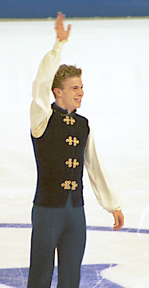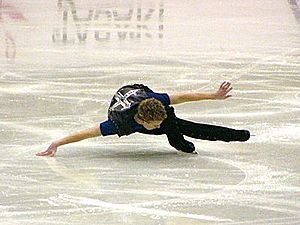Timothy Goebel facts for kids
Quick facts for kids Timothy Goebel |
|
|---|---|

Goebel competes at the 2001 Grand Prix Final in Kitchener, Ontario.
|
|
| Personal information | |
| Full name | Timothy Richard Goebel |
| Country represented | |
| Born | September 10, 1980 Evanston, Illinois |
| Home town | Fairfax, Virginia |
| Height | 1.70 m (5 ft 7 in) |
| Retired | April 25, 2006 |
Timothy Richard Goebel (born September 10, 1980) is a famous American figure skater who used to compete. He won a bronze medal at the 2002 Winter Olympics. He was amazing at quadruple jumps! He was the first person ever to land a quadruple salchow jump in a competition. He was also the first to land three quadruple jumps in one skating program! Before he stopped competing in 2006, he landed a total of 76 quadruple jumps in his career.
Contents
About Timothy Goebel
Early Life and Education
Timothy Goebel was born in Evanston, Illinois, on September 10, 1980. He was adopted as a baby by Ginny and Richard Goebel.
After his skating career, Timothy went to college. He studied at Columbia University and earned a degree in mathematics in 2010. Later, in 2016, he earned a master's degree in data science from New York University Stern School of Business.
Life After Skating
Timothy Goebel has worked in different fields since retiring from skating. He worked for a company that measures TV audiences. Then he joined an advertising agency as a consumer analyst. In January 2017, he started working as a data analyst for Google.
Timothy Goebel married Thomas Luciano on April 29, 2017. Their wedding took place in Newport, Rhode Island.
Timothy Goebel's Skating Career
Becoming the "Quad King"
Timothy Goebel was known as the "Quad King" because he was so good at quadruple jumps. These are very difficult jumps where skaters spin four times in the air.
On March 7, 1998, Timothy made history in Lausanne, Switzerland. He became the first skater in the world to land a quadruple Salchow in a competition. He was also the first American skater to land any type of quadruple jump in a competition.
Making History with Quad Jumps
Timothy continued to break records with his jumps. On October 31, 1999, at the 1999 Skate America event, he became the first skater to land three quadruple jumps in one program. This was a huge achievement in figure skating!
At the 2002 Winter Olympics, Timothy made history again. He was the first skater to successfully land a quadruple Salchow jump as part of a combination in the Olympics. His amazing quadruple jumps made him one of the best skaters in the world during his career. He landed a total of 76 quadruple jumps in competitions.
Improving His Skating Style
Early in his career, some people thought Timothy focused too much on jumps. They felt he needed to improve his choreography and presentation. However, he worked hard and got much better in those areas later on.
Retirement from Skating
After 2003, Timothy started having trouble with his jumps because of injuries. In 2006, he announced that it would be his last competitive season. At the 2006 U.S. Figure Skating Championships, he couldn't land his quadruple jumps or triple Axel cleanly. He finished in seventh place, which meant he didn't qualify for the 2006 Winter Olympics.
Timothy Goebel officially retired from competitive skating on April 25, 2006. He planned to stay involved in the sport as a technical specialist. This role involves helping to judge and score competitions.
Skating Programs
Timothy Goebel performed to many different types of music during his career. Here are some of the programs he skated:
| Season | Short program | Free skating | Exhibition |
|---|---|---|---|
| 2005–2006 |
|
|
|
| 2004–2005 |
|
|
|
| 2003–2004 |
|
||
| 2002–2003 |
|
||
| 2001–2002 |
|
|
|
| 2000–2001 |
|
Second free at Grand Prix Final: |
|
| 1999–2000 |
|
|
|
Competitive Achievements
Timothy Goebel competed in many important figure skating events. Here are some of his top achievements:
- 2002 Winter Olympics: Bronze Medal
- World Championships: Silver Medal in 2002 and 2003
- U.S. Championships: Gold Medal in 2001, Silver Medal in 2000, 2002, 2003, 2005, and Bronze Medal in 1999
- Junior Grand Prix Final: Gold Medal in 1997–98
- World Junior Championships: Silver Medal in 1997


